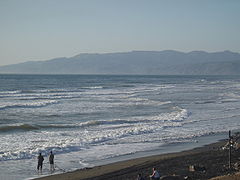- National Ocean Service
-
National Ocean Service Agency overview Formed 1970 Jurisdiction Federal government of the United States Headquarters 1305 East-West Hwy
Silver Spring, MD
38°59′30″N 77°01′48″W / 38.99167°N 77.03°WEmployees 1,259 (FY 2012) Annual budget $559.6 million USD (FY 2012 NOS President's Budget Request) Agency executive David Kennedy, Director Parent agency National Oceanic and Atmospheric Administration Website oceanservice.noaa.gov The National Ocean Service (NOS), an office within the U.S. Department of Commerce National Oceanic and Atmospheric Administration, is responsible for preserving and enhancing the nation’s coastal resources and ecosystems along 95,000 miles (153,000 km) of shoreline bordering 3,500,000 square miles (9,100,000 km2) of coastal, Great Lakes, and ocean waters. Its mission is to "provide science-based solutions through collaborative partnerships to address evolving economic, environmental, and social pressures on our oceans and coasts." NOS works closely with many partner agencies to ensure that ocean and coastal areas are safe, healthy, and productive. National Ocean Service scientists, natural resource managers, and specialists ensure safe and efficient marine transportation, promote innovative solutions to protect coastal communities, and conserve marine and coastal places.
Contents
Organization
As one of five NOAA Line Offices, NOAA's National Ocean Service (NOS) observes, studies, and manages the nation's coastal and marine resources. NOS measures and predicts coastal and ocean phenomena, protects large areas of the oceans, works to ensure safe navigation, and provides tools and information to protect and restore coastal and marine resources.
The shore of the Pacific Ocean in San Francisco, California.
NOS is a scientific and technical organization of 1,700 scientists, natural resource managers, and specialists in many different fields. NOS delivers a dynamic range of nationwide coastal and Great Lakes scientific, technical, and resource management services in support of safe, healthy, and productive oceans and coasts. NOS develops partnerships to integrate expertise and efforts across all levels of government and with other interests to protect, maintain, and sustain the viability of coastal communities, economies and ecosystems.
Protecting coastal communities
NOS prepares coastal communities for change including the effects of natural hazards such as hurricanes, tsunamis, erosion, flooding, and harmful algal blooms. NOS scientists develop tools and information to help coastal managers and communities restore damaged natural resources, deal with the impacts of climate change, and evaluate contaminants and monitor cleanup efforts.
NOS is a steward and manager of marine resources including marine sanctuaries, estuarine reserves, marine protected areas, and coral reefs. NOS scientists support coastal zone management and are marine oil spill first responders. Researchers focus on issues relating to marine debris, coastal and estuarine land conservation, conservation of coral reefs, and natural resource assessment and restoration.
Ocean and human health
NOS provides early-warning systems and forecasts for threats to human health and coastal economies. NOS collects integrated ocean and coastal observations. NOS monitors both natural and human impacts on ecosystems and provides tools and training to help coastal managers make good decisions about managing coastal and ocean resources.
NOS scientists perform many activities to support safe and efficient marine navigation. NOS provides updated nautical charts, hydrographic surveys, and aerial photography to help mariners navigate safely. NOS scientists monitor and predict tides and currents, coordinate more than 1,000 global positioning reference stations, conduct hazardous obstruction surveys, and provide techniques to establish accurate elevations.
NOS capabilities
NOS consists of eight program offices and two staff offices that manage and preserve the nation's ocean and coasts. Specifically, NOS:
- Provides products, services, and data, such as nautical charts, a framework for consistent geographic reference, and tidal and water-level monitoring.
- Manages 13 national marine sanctuaries and one national monument and provides funding to coastal states to manage 27 national estuarine research reserves.
- Participates in immediate response to hazardous spill events, damage assessment, and restoration activities.
- Supports states in protecting resources and guiding economic development in coastal areas. NOS also supports training for state coastal managers participating in the program.
- Assesses, monitors, and predicts the consequences of natural and human-induced environmental hazards such as hurricanes, erosion, and sea-level rise.
NOS organization
NOS is organized into program offices, programs, and staff offices:
Program Offices:
- Center for Operational Oceanographic Products and Services (CO-OPS)
- NOAA Coastal Services Center (CSC)
- National Centers for Coastal Ocean Science (NCCOS)
- Office of Coast Survey (OCS)
- Office of National Geodetic Survey (NGS)
- Office of National Marine Sanctuaries (ONMS)
- Office of Ocean and Coastal Resource Management (OCRM)
- Office of Response and Restoration (OR&R)
Programs:
- NOAA Integrated Ocean Observing System (IOOS) Program
Staff Offices:
- International Program Office (IPO)
- Management and Budget Office (MBO)
See also
References
External links
- National Ocean Service (NOS)
- Center for Operational Oceanographic Products and Services (CO-OPS)
- NOAA Coastal Services Center (CSC)
- National Centers for Coastal Ocean Science (NCCOS)
- Office of Coast Survey (OCS)
- Office of National Geodetic Survey (NGS)
- Office of National Marine Sanctuaries (ONMS)
- Office of Ocean and Coastal Resource Management (OCRM)
- Office of Response and Restoration (OR&R)
- NOAA Integrated Ocean Observing System (IOOS) Program
- International Program Office (IPO)
- Management and Budget Office (MBO)
- National Oceanic and Atmospheric Administration (NOAA)
Categories:
Wikimedia Foundation. 2010.

